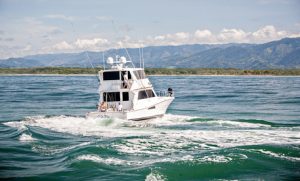 The world’s sport fishermen and women have their own bucket list of places they desperately want to go fishing before they die. Locations all over the world beckon because of their huge variety of species, the challenges of trying to catch them, fish flavors when cooked skillfully, the beauty of these animals, and more. A sport fishing enthusiast is attracted to sunny locations or, if they are thrill seekers, challenging ones. Costa Rica is one of the most popular places on the globe for sport fishing. Find out why, but also discover resources to help get you there.
The world’s sport fishermen and women have their own bucket list of places they desperately want to go fishing before they die. Locations all over the world beckon because of their huge variety of species, the challenges of trying to catch them, fish flavors when cooked skillfully, the beauty of these animals, and more. A sport fishing enthusiast is attracted to sunny locations or, if they are thrill seekers, challenging ones. Costa Rica is one of the most popular places on the globe for sport fishing. Find out why, but also discover resources to help get you there.
Costa Rican Fishing Flexibility
There are more than a dozen popular fish swimming off the two coastlines of Costa Rica or in fresh water. For this reason, there is virtually no time of the year when these waters are not teeming with some kind of species worth hauling out of the water, though there are better and less favorable times. These are determined by weather conditions and also by the size fish will be at a point in the year. It’s best to let them get as big as they can be, but also worth trying to visit outside of “high season” in order to save money and avoid crowds. Visitors from many parts of the United States, Canada, and Europe will find the temperature lovely and enjoy the sunshine even as locals complain that it’s getting a bit chilly.
Both the Atlantic and Pacific Oceans touch the shores of this South American country and some fish favor one side or the other. Others don’t seem to mind where they go, migrating to either side from previous destinations such as Hawaii. Common species include Sailfish, Dorado (Mahi Mahi), Marlin, and Wahoo. Besides fishing, there are also many water sports available on both sides when you need a break.
Costa Rica Fishing Information
The internet is an exceptional resource full of ideas. Learn the names of species and details about them, such as whether or not to eat a Snook and, if so, how to cook it. Find out when fish are around or when fishing is permitted; what sorts of charters are available; weather in Costa Rica during particular times of year; and how to prepare for a trip to this part of the world to be as safe as possible. Learn where resorts and hotels are in relation to good fishing spots and other attractions for days off from fishing or for non-fishing traveling companions.
Resources for Costa Rica Sport Fishing
Resorts themselves feature websites and they use these as means of advertising by posting useful links. These include connections to charter boat companies, fishing supply stores, and even to environmental and educational sites. A business might write its own blog about what it is like to work and play in Costa Rica with some fun articles about sport fishing and even photographs.
Read travel pages where resorts and charters are listed. These will direct readers to specific locations, explaining what fish are available in those places. They might be travel sites for Tamarindo, Samara, or Playa del Coco or generic sites which provide information about all these and more.
Choose a site dedicated to fishing tour, like costaricasportfishingtours.com for example. These describe the questions you want to ask when hiring a captain such as how much experience the captain has on these waters, final costs after all fees are calculated, and whether or not the vessel would pass a safety inspection. Are there life jackets, flares, an anchor, and a working radio? Is the captain certified?
Go directly to government or environmental pages where information is non-promotional. These resources provide an unbiased glimpse of sea and inland fishing possibilities such as simplified images of fish, a small amount of basic data, the fishing season for each one, and its approximate location along the coast or inland.
Read blogs not dedicated to Costa Rica but more generally interested in sport fishing. Writers share their encounters with fish in this country and sometimes compare their time here with fishing in other parts of the world, supplying a new perspective. Their blogs might relate to fishing with teens or in groups where someone is a first-timer. Here, you might uncover some tips which help a beginner get his or her feet wet while staying safe and still catching something to whet the appetite for future trips to this part of the world.